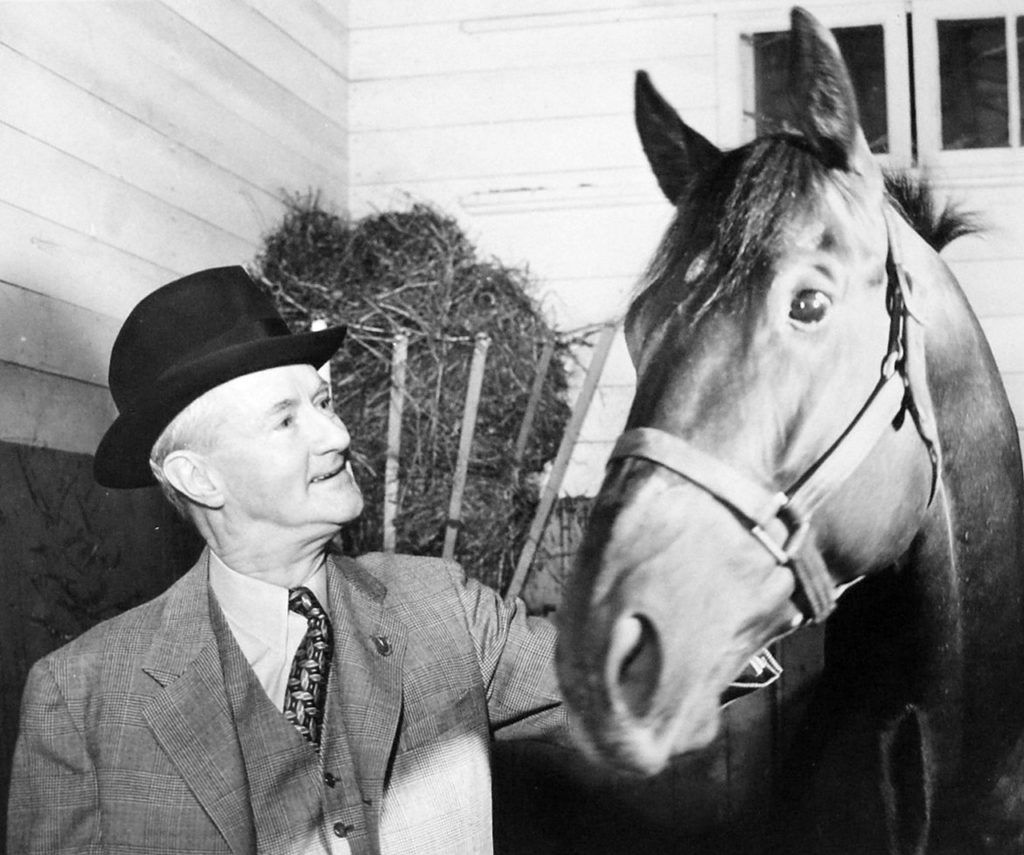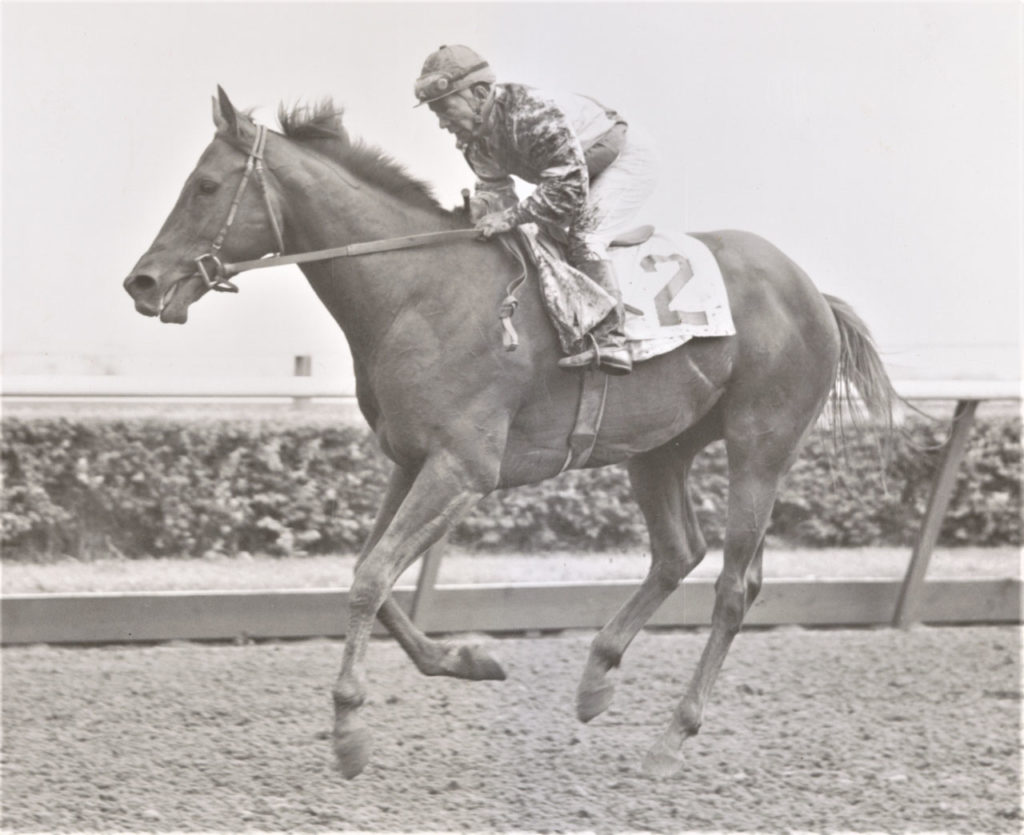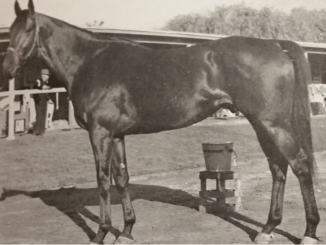
Georgeff, Denman, Durkin’s Call, and Beemie Award — just a few of the horses over the years named directly or indirectly in honor of prominent track announcers. It was a trend that began decades ago and, perhaps fittingly, the best of these runners was named for the original voice of racing: Clem McCarthy.
***
The crop of colts foaled in 1954 is often judged the most talented and accomplished in American racing history. Led by Hall of Famers Bold Ruler, Round Table, and *Gallant Man, the list also includes Calumet Farm’s Iron Liege, who shockingly beat the above three in the Kentucky Derby, and the ill-fated Gen. Duke, the more highly regarded of the Calumet colts.
Another who made a notable impact on the track, albeit further down the road, was Clem. Foaled at Spendthrift Farm 10 days before Bold Ruler’s and Round Table’s arrival on the same night at Claiborne, Clem was bred by Hollywood mogul Louis B. Mayer.
From a racing perspective Clem’s sire, *Shannon II, was one of the more successful Australian imports ever. A member of his native country’s Hall of Fame, *Shannon II was generally judged the leading older horse of 1948 when, transferring his top form to dirt, he won six stakes in California including the Hollywood Gold Cup. *Shannon II eventually stood at Spendthrift.
Later described by turf writer Frank Talmadge Phelps as a “blocky, muscular, rather temperamental colt, standing about 15 1/2 hands,” Clem was sold for $8,500 at the 1955 Keeneland July sale to Adele Rand, grandmother of prominent horsewoman Adele Dilschneider (who today uses Rand’s Confederate gray and blue-colored silks). Rand subsequently named the colt for the then-retired McCarthy, whose calls of the Kentucky Derby and other important races during the golden age of radio made him a household name among sportscasters.

To say Clem was born at the wrong time would be an understatement in not one but two respects. Although clearly not the caliber of his more illustrious peers on a consistent basis, in another era he might have proved a highly-accomplished grass performer. A handful of efforts Clem made in turf stakes suggests as much, but like others of his time, he generally had to make do with a career on the dirt as top-level grass opportunities were relatively scarce.
They were completely nonexistent at the time in New York, where Clem was primarily based with Bill Stephens, a younger brother of Hall of Fame trainer Woody Stephens. It was initially a tough scene for a son of an Australian champion and out of a mare descended from Epsom Derby hero *Mahmoud.
Although a winner on debut, Clem would place in only two of seven stakes appearances on the main track, most notably a second in the Saratoga Special to Nearctic (later the sire of Northern Dancer). His biggest success of the season occurred in the one-mile Absecon Island at Atlantic City, at the time an extremely rare stakes opportunity on the turf for juveniles.
Clem didn’t develop into a Triple Crown contender in the spring of 1957, thus largely avoiding conflict with the big bears of the division. However, he proved a much more consistent performer at three when finishing in the money in all nine stakes attempts. All but two were around one turn, suggesting he initially might have been viewed as distance limited.
The highlight of his campaign was a three-stakes win streak in the summer which included the Withers at Belmont Park and the Arlington Classic. The latter victory came at the expense of Kentucky Derby winner Iron Liege, who had beaten Clem in the Jersey (Derby) at Garden State Park three starts earlier. A bruised foot incurred during a third-place finish in the Sheridan H. at Arlington ended Clem’s season prematurely.

Clem’s 4-year-old season would prove his most noteworthy, though it was slow into stride as he lost his first 11 stakes attempts. Despite receiving significant concessions in weight, Clem lost the Toboggan H. by a half-length to Bold Ruler while getting 16 pounds from the reigning Horse of the Year. He later finished third behind *Gallant Man and Bold Ruler in the Met Mile, getting 16 and 21 pounds, respectively, and subsequently gave Bold Ruler another scare in the Suburban H. but fell a nose short while in receipt of 25 pounds.
Shifting to Chicago for a late summer campaign, Clem proved a more effective thorn in the side to Round Table. In the Laurance Armour Memorial (video below) over the Arlington turf, Round Table just caught Clem in the final jump to win by a nose while conceding 20 pounds. Clem subsequently finished ahead of Round Table in the Equipoise Mile on the main track, but Round Table bounced back to take the Arlington H. on turf over Clem by 2 1/4 lengths while giving 21 pounds.
It was now Clem’s turn to shine. In the Washington Park H. on Labor Day, Clem sped the one-turn mile in an Arlington track-record of 1:34, beating Round Table by 3 1/4 lengths. The latter, who stumbled at the start, again had conceded 21 pounds.

Their next meeting, in the United Nations H. at Atlantic City on turf, involved an interesting game of musical jockeys. Bill Shoemaker, Round Table’s regular rider, was committed to riding *Gallant Man over Round Table all season and thus was to ride that colt in the United Nations. Securing the mount on Round Table for the United Nations, and for any race where they’d potentially meet that fall, was Eddie Arcaro. When *Gallant Man was withdrawn from United Nations consideration, Shoemaker picked up the mount on Clem and had to stick with him even after Arcaro belatedly declined the ride on Round Table in the United Nations due to illness.
Knowing the favorite as well as anyone, and with a 17-pound weight advantage, Shoemaker turned in a tactically crafty ride aboard Clem. Dueling for the lead through the first 7 furlongs, Clem opened up a two-length advantage in upper stretch and lasted by a half-length over the reigning United Nations winner in course-record time of 1:54 3/5 for 1 3/16 miles. Shoemaker would win a third consecutive United Nations when Round Table returned to the Atlantic City winner’s circle the following year.
Clem met Round Table for a final time in the 1 1/4-mile Woodward at Belmont Park, this time at equal weight of 126 pounds. Unfortunately for Round Table, heavy wind and rain brought on by the approaching Hurricane Helene turned the track sloppy, a condition he was not fond of. With Shoemaker again aboard Clem, he and Round Table dueled through the opening 6 furlongs before the latter steadily dropped back. Clem eventually won by a half-length in an excellent time of 2:01, with Round Table 17 lengths adrift in fifth.
***
While Round Table would clinch Horse of the Year honors in the Hawthorne Gold Cup in his next start, Clem’s campaign ended with a whimper on the East Coast. Conceding weight in the Manhattan H. over 1 1/2 miles on the main track as an odds-on choice, Clem rated behind a slow pace set by a loose-on-the-lead rival and finished third. He next set too fast a pace in the two-mile Jockey Club Gold Cup and faded to last in a field of seven.
Despite those setbacks, Clem started as second choice to Prix de l’Arc de Triomphe winner *Ballymoss in the Washington D.C. International at Laurel in his season finale. Unfortunately, as the race chart noted succinctly, “Clem failed to recover after *Ballymoss was knocked into him at the clubhouse turn.” The roughly-run race produced its first disqualification when *Tudor Era was placed second behind Australian import *Sailor’s Guide after a separate incident, with Ballymoss third and Clem eighth after receiving a hard blow to a stifle.
Clem never had another opportunity to race on turf. Sidelined following a victory in the 7-furlong Palm Beach H. at Hialeah in early 1959, he ran unplaced in a pair of overnight events later that year before his retirement. He earned $535,681 (roughly $4.8 million today) from a record of 47-12-8-13. His stakes record was 35-8-8-9.
Far from a high-profile stud, Clem’s offspring included Acclimatization, who followed in his sire’s hoofsteps winning the 1972 United Nations, and Out the Window, who avenged his father’s loss when taking the 1968 Laurance Armour, among other stakes.
Clem McCarthy died in 1962, his sad final years spent in extreme poverty while suffering from the effects of Parkinson’s disease. How much he may have relished the success of his namesake Thoroughbred is not readily known, and all these years later we still await the next Grade 1-quality star named for one of the boys in the booth.



